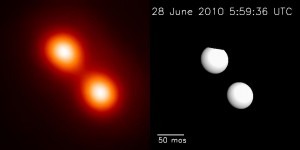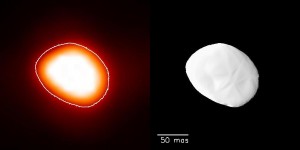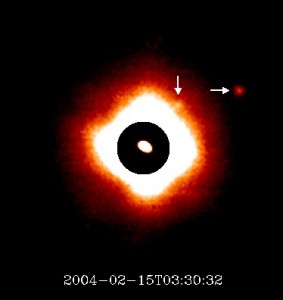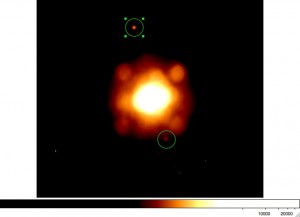Keck AO Observations: Multiple Asteroid Systems
Keck AO Observations: Io Volcanism – "Mornes plaines"
July 15, 2010FIRST@LICK: The Project
July 24, 2010I mentioned in my previous post that we observed several known multiple asteroid systems during our last observing run with the W.M. Keck Observatory and its Adaptive Optics Systems. If you have been following my blogs and/or the scientific articles of our group (you are courageous…) you should know that this is the scientific topic which is taking most of my time recently. Today, as you can see if you explore our VOBAD database, we know 192 companions of asteroids. What I meant by “we know” is that one group announced to have discovered one or several satellites using techniques such as:
- lightcurve measurements (44% of them) for which we detect mutual events (eclipse/occulation between components) or multi-frequency variations (due to the asynchronous spin of the components)
- Radar observations (12%). We detect the echo of a radar-wave which bounces on the components of the system when it is close to Earth (mostly limited to NEAs)
- high angular resolution direct imaging using the Hubble Space Telescope (28%) or adaptive optics on 8-10m class telescopes (16%)
My group is using essentially AO technique to search for new multiple asteroid systems. However, we also to monitor them to derive the orbital elements of the orbits, so to derive the mass of the system, the size and shapes of the components, an estimate of their ages, surface composition and so on. The goal of this study is to uncover clues concerning the formation and evolution of these mini-planetary systems.
During our last run, we observed several known multiple asteroid systems. My colleague, Pascal Descamps from the IMCCE, used our processed data to compare these observations with the shape predicted with our orbital models.
Let’s start with (90) Antiope, a doublet binary system (Type-2 based in our VOBAD nomenclature) , made of two ellipsoidal components with an average diameter of 91 km and 86 km, orbiting at ~171 km around their center of mass in 16.5 h. Its bulk density is quite low, estimated to 1.3 g/cc, implying an rubble pile interior or an internal composition saturated with water ice.
As you can see the observed position of the two components (left) is in excellent agreement with our orbital model (right). The model shows a large 68-km bowl-shaped crater on one of the components that was introduced to better fit the lightcurves observed in 2007. Unfortunately, we can’t resolve it using the W.M. Keck II telescope so we will need an image from a 30m-class telescope or a space mission to be able to confirm its genuineness. We think that this system is one of the most primitive binary asteroid which is the result of the catastrophic disruption of a large 450 km asteroid which happened 2.5 Byrs. It is still unclear how it became a doublet asteroid, it may have split due to fission after an oblique impact on one of the components (hence the large crater), but simulations are needed to confirm this scenario.
(22) Kalliope is a Type-1 binary system, composed of a large 166-km irregularly shaped primary and a 28-km satellite (named Linus) that we studied intensively in 2007. From this study we derived a new shape model and derived a large bulk density of 3.35 g/cc. The picture below shows a comparison between the resolved image of the primary and the new shape model. As you can see the agreement is striking.
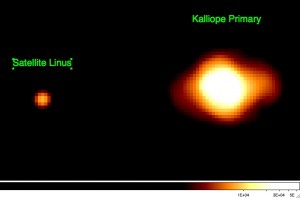
We also detected the satellite, as shown on the image on the left. We are happy to report that its measured position is very close (6.5 milli-arcsec to be precised) to the position predited by our new dynamical model (developed by F. Vachier and J. Berthier). More news on this…
(45) Eugenia is the last interesting system that we observed with Keck AO. This is a Type-1 triple asteroid system, made of a large 217 km ellipsoidal primary and TWO 5 & 7 km satellites orbiting at ~600 and ~1200 km. We discovered the second satellite in 2007 after reprocessing carefully several VLT/NACO data recorded in 2004 (see below the left image. The arrows indicate the positions of the moons). With this improved version of the Keck AO system, and because of the large aperture of the telescope, the second and closer moonlet is easily detected as shown in the figure below (see the green circles on the right image).
It is motivating to see how the improvement in imaging quality of an AO systems allow us to see smaller & closer satellites around asteroids. The same technique is used to search for faint exoplanets around nearby stars like the recently discovered Beta Pic B.
That’s all for multiple asteroids… Tomorrow I will write about our new instrument about to be tested at Lick Shane-3m telescope.
Clear skies
F.
